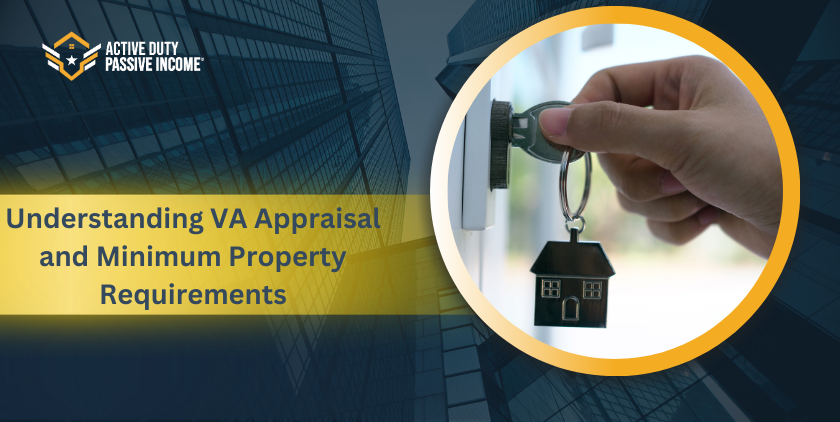Embark on your journey to homeownership with confidence: Master the VA appraisal process and property requirements!
Navigating the world of real estate can be complex, especially when it comes to securing a mortgage. For veterans and active-duty military members, the VA loan program offers a unique opportunity to purchase a home with favorable terms. However, one critical aspect of this process is the VA appraisal, which ensures that the property meets specific standards and is worth the purchase price. This blog delves into the intricacies of VA appraisals and the minimum property requirements (MPRs) set by the Department of Veterans Affairs.
What is a VA Appraisal?
A VA appraisal is a mandatory step in the VA loan process designed to protect both the buyer and the lender. Conducted by a licensed appraiser approved by the VA, this appraisal serves two primary purposes: to determine the market value of the property and to ensure it meets the VA’s minimum property requirements.
Determining Market Value
The appraiser evaluates the property’s market value by comparing it to similar homes in the area that have recently sold. This comparison helps establish a fair market price, ensuring that the veteran or service member is not overpaying for the property. The appraised value also influences the loan amount, as lenders typically will not finance more than the home’s appraised value.
Ensuring Property Meets MPRs
Beyond establishing market value, the VA appraisal ensures the property meets specific minimum property requirements. These standards are in place to guarantee the home is safe, sanitary, and structurally sound, protecting the health and safety of the veteran and their family.
Minimum Property Requirements
The VA’s minimum property requirements cover a wide range of aspects, from the structure and mechanical systems to safety and sanitation. Here are some of the key areas appraisers focus on:
Structural Soundness
The property’s foundation and overall structure must be free of major defects. This includes ensuring there are no significant cracks in the foundation, walls, or ceilings. The roof should be in good condition with no leaks, and all mechanical systems (plumbing, heating, and electrical) must be functional and safe.
Safety
The safety requirements are extensive, covering various aspects of the property. For example, stairs, decks, and porches must have proper railings, and windows in every bedroom must provide an emergency exit route. Additionally, the property must be free of lead-based paint hazards, which is particularly important in homes built before 1978.
Sanitation
Sanitation standards ensure that the property has adequate water supply and waste disposal systems. The home must have a reliable and safe water supply, and the sewage system must be functional and properly connected. This includes checking for any potential issues with septic systems and ensuring that there are no leaks or water damage within the home.
Heating and Cooling
The home must have a reliable heating system capable of maintaining a comfortable temperature during the winter months. In some regions, a cooling system may also be required. The appraiser will check that the heating and cooling systems are in good working order and do not pose any safety hazards.
Pest Control
The property must be free of termite infestations and other pest-related issues. In many areas, a pest inspection is required to ensure that the home is not infested with termites or other wood-destroying insects. If any evidence of infestation is found, it must be addressed before the loan can be approved.
The Appraisal Process
Understanding the appraisal process can help veterans and service members better prepare for what to expect. Here’s a step-by-step overview:
Ordering the Appraisal
Once the purchase agreement is signed, the lender will order the VA appraisal. The appraisal must be conducted by a VA-approved appraiser who understands the specific requirements and standards set by the Department of Veterans Affairs.

Conducting the Inspection
The appraiser will visit the property to conduct a thorough inspection. During this visit, they will assess the overall condition of the home, measure its dimensions, and compare it to similar properties in the area. The appraiser will also take note of any repairs or improvements that may be necessary to meet the MPRs.
Completing the Report
After the inspection, the appraiser will compile their findings into a detailed report. This report includes the appraised value of the property and a comprehensive evaluation of its condition. If the property does not meet the VA’s minimum property requirements, the appraiser will list the specific issues that need to be addressed.
Reviewing the Report
The lender will review the appraisal report to determine whether the property meets the VA’s requirements. If the property appraises for at least the purchase price and meets all MPRs, the loan process can proceed. However, if the appraisal identifies issues, these must be resolved before the loan can be approved.
Common Issues and Solutions
It’s not uncommon for VA appraisals to uncover issues that need to be addressed before the loan can be approved. Here are some common problems and potential solutions:
Property Value Lower Than Purchase Price
If the appraised value is lower than the purchase price, the buyer has a few options. They can negotiate with the seller to lower the price, pay the difference out of pocket, or request a reconsideration of value if they believe the appraisal was inaccurate.
Repair Requirements
If the appraisal identifies necessary repairs, these must be completed before the loan can be finalized. The seller typically handles these repairs, but buyers can also negotiate to take on the responsibility if they prefer. It’s important to ensure that all repairs meet the VA’s standards and are completed by licensed professionals if required.
Tips for a Smooth Appraisal Process
To ensure a smooth appraisal process, here are some tips for veterans and service members:
Choose the Right Property
Selecting a property that is in good condition and likely to meet the VA’s MPRs can save time and hassle. Homes that are well-maintained and free of major issues are more likely to pass the appraisal with minimal required repairs.
Prepare for the Inspection
Before the appraisal, make sure the property is in its best possible condition. Address any minor repairs that could potentially cause issues, such as fixing leaky faucets, replacing broken windows, or clearing any debris from the yard.
Work with Experienced Professionals
Working with a real estate agent and lender experienced in VA loans can make the process smoother. These professionals understand the unique requirements of VA appraisals and can provide valuable guidance and support throughout the process.
Understand the Requirements
Being familiar with the VA’s minimum property requirements can help buyers identify potential issues early on. This knowledge can also help during negotiations with the seller and ensure that any necessary repairs are completed to meet the VA’s standards.
Conclusion
The VA appraisal and minimum property requirements are essential components of the VA loan process, designed to protect both the buyer and the lender. By ensuring that the property is safe, sanitary, and structurally sound, these standards help veterans and service members secure a home that meets their needs and provides long-term stability.
Understanding the appraisal process and the VA’s requirements can help buyers navigate this crucial step with confidence. By choosing the right property, preparing for the inspection, and working with experienced professionals, veterans and service members can achieve their dream of homeownership with the support and benefits of a VA loan.
Whether you’re a veteran looking to purchase your first home or an active-duty service member seeking to relocate, the VA loan program offers an excellent opportunity. By familiarizing yourself with the appraisal process and minimum property requirements, you can ensure a smooth and successful home-buying experience.







